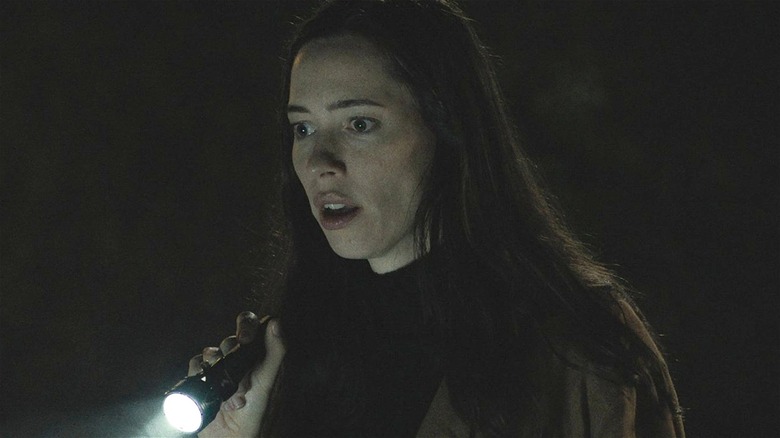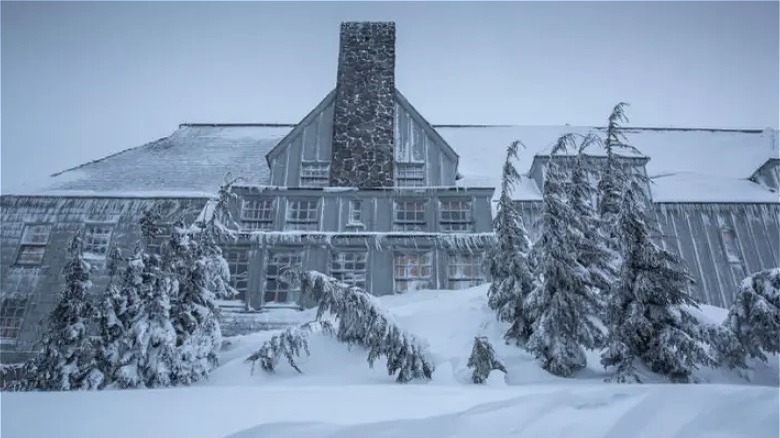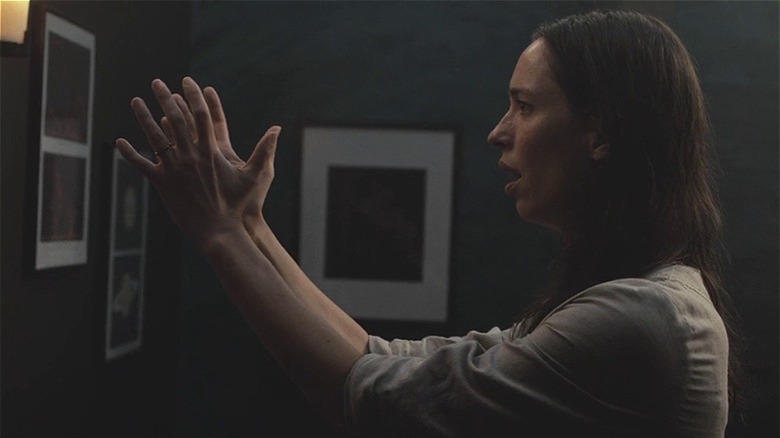The Mind-Bending Inspiration Behind The Night House's Twisting Architecture
A woman grieving her husband's death, an eerie, identical house in the woods with a reversed floor plan, and an entity hellbent on dragging a living person to the realm of death. These are the essential ingredients in David Bruckner's psychological horror, "The Night House," which, when combined, leads to a terrifying tale about grief, loss, and emotional trauma.
There are several reasons why Brucker's tale is haunting, which include a meticulous dedication to creating a tense atmosphere and sound design within a setting meant to confuse and disorient. However, the effectiveness of "The Night House" would be incomplete without the mechanics of the titular house, which becomes the site of horror for the protagonist, Beth (Rebecca Hall).
After Beth loses her husband, Owen (Evan Jonigkeit), to suicide, she experiences jarring supernatural events inside her beautiful, secluded home, which Owen had built for the both of them. Amid unaccounted time gaps, strange visions, and a chilling discovery about her husband's actions before his death, Beth stumbles upon a reversed copy of her house in the woods. This aspect of architectural mirroring ushers in psychological and emotional revelations, while the threshold between dreams and reality starts to blur. What were the inspirations behind the dizzying architecture of the house that lies at the heart of the story? Let's find out.
Playing with perception
Horror films often rely on architectural and spatial aspects to evoke claustrophobia and anxiety, and haunted houses have always been a staple trope in the genre. Some films excel in using this aspect to the plot's advantage, and a classic example is "The Shining." The film's disturbing events take place exclusively inside the Overlook Hotel, which emerges as an entity in its own right, as its halls and rooms hold decade-old secrets waiting to be uncovered. Fans of "The Shining" have analyzed the blueprint of the Overlook and come to the conclusion that it is an impossible labyrinth, much like the hedge maze that is present within the grounds.
The architectural elements of Bruckner's film are heavily inspired by the Overlook's design, and the director specifically mentions Rodney Ascher's "Room 237," a documentary that attempts to analyze "The Shining" through the lens of conspiracy theories. In an interview with The Playlist, Bruckner explained that he was fascinated by the theory of "the impossible window" in "The Shining," and how it was an inspiration for "The Night House." According to him, the idea of impossible architecture (that the audience is aware of) adds to the surreal nature of a story, where the director might or might not deliberately intend to use this trope as a "subconscious loop."
While it is unclear whether Stanley Kubrick meant for the "impossible" window in "The Shining" to exist, Bruckner and his team deliberately used an improbably reversed building to heighten the horror of Beth's predicament. The mirrored house is the site of several murders where (spoilers!) women who look like Beth have been killed to trick a primordial entity. Hence, the space is not only charged with violence and witchcraft but also emerges as a symbol of Owen's love for Beth.
An unconventional literary inspiration
In the same interview linked above, Bruckner cites "House of Leaves" as a key influence on his film's architectural elements, clarifying that "geography horror" played a seminal role in the making of the film:
"Another influence is not cinematic: the book 'House of Leaves,' by Mark Z. Danielewski. It was a huge inspiration and an early conversation point between myself, Ben Collins, and Luke Piotrowski, even before they wrote that script. It was just this idea of geography horror being underplayed, that we haven't seen enough of. It lends itself to cinema in so many different ways, and there's something terrifying about it."
Danielewski's "House of Leaves" is dizzying in terms of narrative structure, as it uses unconventional methods of storytelling to induce the sensation of being lost within a labyrinth. Words are often arranged to form the outline of an object or placed in ways to evoke disorientation and anxiety. Some metaphors are also color-coded and reappear in many instances to create a chain of meaning that needs to be put together like a puzzle by the reader.
It is interesting that Bruckner chose "House of Leaves" as a key inspiration, as the novel uses unique techniques to engage with the psyche of the reader. Bruckner does the same with his audience with the aid of unconventional shots and metaphorical transpositions to deliberately confuse dreams with waking reality. The fact that "The Night House" can be interpreted either as a straight-cut horror or a metaphor for crippling depression, or both, depends on the worldview of the viewer, who plays a critical role in informing the film's layered world-building. As Beth finds a way out of the labyrinth of her suffering, so does the viewer, using a self-created method of catharsis.


